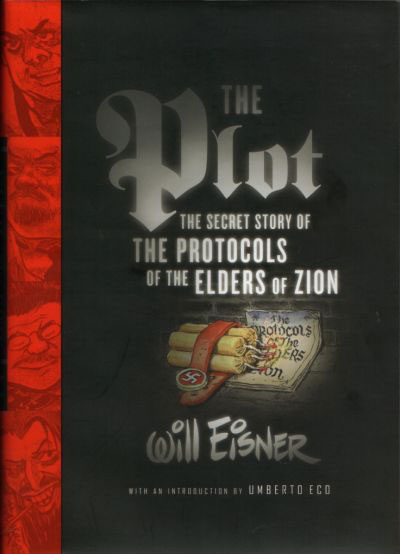Torching the Protocols
The Plot: The Secret Story of the Protocols of the Elders of Zion
I found this a couple weeks ago and was actually really excited to get it. I’d heard that Will Eisner was working on this a few years before he died in 2005, but I’d never managed to find this in stores and assumed it was out of print by now — I was glad to see I was mistaken.
Basically, Eisner — one of the most important creators in the history of comics, creator of “The Spirit,” creator of what’s considered the first graphic novel — decided a few decades back that he wanted to research and write a history of “The Protocols of the Elders of Zion.” If you’re fortunate enough not to be aware of that, it’s a very old anti-semitic hoax claiming to represent a ploy by Jews to take over the world.
Eisner starts his story all the way back in 1848, with a French writer named Maurice Joly, a critic of Napoleon III. Joly wrote a book called “The Dialogue in Hell Between Machiavelli and Montesquieu,” a coded, over-the-top denunciation of Napoleon III as a diabolical dictator who intended all manner of cartoonish evil for France and the rest of the world. Joly’s book was mostly forgotten until 1894, when members of the Russian secret police resurrected it in a bid to influence Tsar Nicholas II. Some creative rewriting of Joly’s book, and the focus was changed from Napoleon III to the ever-popular scapegoats in the Jewish population.
And a couple decades later, Hitler got his rotten hands on it. And from there, it was off to the races.
Artistically, I think this has Eisner near the top of his game, which is pretty awesome, considering that he finished it only a few months before his death. Lots of wonderfully expressive faces and postures — most of the work here looks just as fantastic as anything he ever did on “The Spirit.” It’s a bit of a shock at times to see how much Eisner uses really insulting caricature — one of the characters is depicted as a dead ringer for Rasputin — but on the other hand, a lot of the characters depicted were responsible for the most disgustingly hate-filled rhetoric on the planet, and it’s a bit hard to work up much sympathy for them. So they’re depicted as ugly, barely human cartoons? Well, turn-about is fair play.
On the other hand, there’s a lot less art than you’d probably expect. The entire book is very text-heavy. Page and pages are devoted to side-by-side comparisons of Joly’s “Dialogue in Hell” and the Protocols, along with vast amounts of background and analysis. Eisner was clearly thinking of this less as a comic book and more as a simple history book with some illustrations. But if you’re expecting a fast, cartoon-filled read, you’re not going to get it — reading the whole thing is a bit of a slog.
One of the interesting — and I suppose, depressing — elements of the tale is how frequently the Protocols get debunked, always in high profile exposes in prominent publications and by powerful organizations — and every time, the debunkers allow themselves their moment of triumph and think, “Surely, this is the end of the Protocols. No one will ever believe it now.” And every time, the damned Protocols just keep on going and going. Eisner was at least under no illusions about what effect his graphic novel would have on the people who wanted to believe lies. In other words, don’t get this expecting a happy, uplifting ending — hate always finds a way forward, unfortunately.
Verdict: Thumbs up. But with some reservations. When I said it was a slog to get through, I mean, seriously, it was a major slog to get through. The side-by-side comparison, for example, while certainly informative, ran the narrative straight into a brick wall. This is less a graphic novel and more a graphic historical narrative.
Nevertheless, it’s still worth reading. It may be a slog to read as a comic book, but it’s much quicker to read than a full-length history of the Protocols would be — and it’s clear that Eisner meant it to be that way. He didn’t mean this to be the be-all-and-end-all of Protocol histories — he knew that more complete books had already been published and more would eventually follow. So this was, I think, always meant to be more of a fast summary of events — enough to quickly refute the Protocols and get other readers interested in more of the history (the book includes a nice bibliography).
And again, you get some really outstanding Will Eisner artwork. So you get to enjoy awesome comic art and strike a blow against haters and Nazis at the same time. Sounds like more than enough reason to pick it up…

